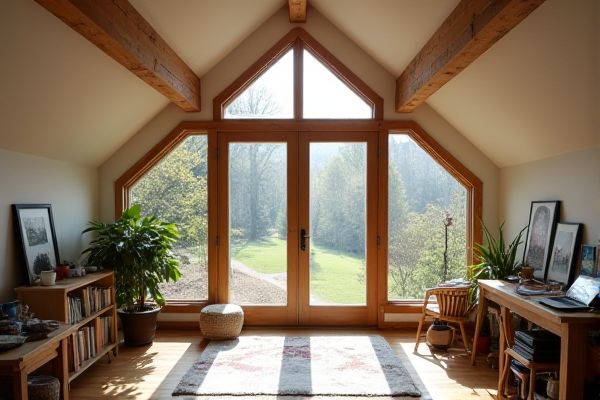
An attic art studio offers seclusion and creative energy from an elevated, quiet space, while a sunroom studio provides abundant natural light and scenic views that can inspire your artwork. Explore this article to discover which studio setup best suits your artistic needs and lifestyle.
Table of Comparison
| Feature | Attic Art Studio | Sunroom Studio |
|---|---|---|
| Natural Light | Moderate, limited by roof windows or skylights | High, large windows on multiple sides |
| Temperature Control | Often less insulated, can be hot/cold seasonally | Better insulation, generally more comfortable year-round |
| Space | Typically smaller, sloped ceilings limit usable area | Usually more spacious and open |
| Ventilation | Limited, depends on window placement | Good airflow with operable windows and doors |
| View | Limited to roofline or neighborhood rooftops | Expansive outdoor views, garden or landscape |
| Privacy | High, secluded from main living areas | Lower, often visible from outside |
| Cost of Setup | Moderate, may require insulation and skylight installation | Higher, involves window installation and weather-proofing |
| Ideal For | Artists needing quiet, secluded space | Artists needing abundant natural light and connection to outdoors |
Introduction: Choosing Your Creative Space
Attic art studios offer a cozy, secluded environment with abundant natural light filtered through skylights, ideal for focused creativity and minimizing distractions. Sunroom studios provide expansive windows and direct sunlight, creating an inspiring atmosphere that connects you with the outdoors while enhancing mood and energy levels. Selecting between an attic art studio and sunroom studio depends on your preference for privacy versus immersion in nature, ensuring your creative space supports your artistic flow.
Natural Light: Attic vs Sunroom
Sunroom studios benefit from abundant natural light due to their large windows and glass ceilings, creating a bright and inspiring workspace throughout the day. In contrast, attic art studios often have limited or smaller windows, resulting in less natural illumination and a reliance on artificial lighting. The sunroom's exposure to sunlight can enhance color accuracy and mood, which is crucial for detailed artistic projects.
Ventilation and Air Quality
Attic art studios often face challenges with ventilation due to limited window options and confined spaces, which can lead to poor air circulation and accumulation of fumes from art materials. In contrast, sunroom studios typically benefit from large windows and multiple openings, allowing for superior airflow and natural ventilation that improve air quality. Proper ventilation in sunroom studios reduces humidity and airborne toxins, enhancing comfort and health during extended creative sessions.
Temperature Control and Insulation
Attic art studios often face temperature fluctuations due to less effective insulation and proximity to the roof, leading to heat buildup in summer and cold drafts in winter. Sunroom studios benefit from large windows and glass walls but require specialized glazing and thermal treatments to maintain consistent temperature control and prevent heat loss. Your choice depends on the balance between natural lighting preferences and the investment needed for adequate insulation and climate management.
Privacy and Distraction Levels
An attic art studio offers superior privacy and minimal distractions due to its secluded location, often isolated from the main living areas. In contrast, a sunroom studio typically faces more exposure to outdoor views and household activity, which may increase distractions but also provide natural light. Your choice depends on whether you prioritize quiet focus or a vibrant, light-filled atmosphere.
Storage Solutions for Art Supplies
Attic art studios often provide unique storage nooks within eaves and built-in shelves that maximize limited space for organizing paints, canvases, and brushes efficiently. Sunroom studios benefit from custom storage furniture that blends seamlessly with natural light, keeping your art supplies visible yet neatly contained to inspire creativity. Choosing between the two depends on your need for compact, hidden storage versus easily accessible, well-lit work areas.
Aesthetic Appeal and Inspiration
Attic art studios often feature unique architectural details like exposed beams and skylights that create cozy, inspiring environments rich in natural light and personalized charm. Sunroom studios offer expansive windows and panoramic views, flooding your space with sunlight and a connection to the outdoors that can boost creativity and mood. Choosing between the two depends on your preference for intimate, character-filled aesthetics versus bright, open environments for artistic inspiration.
Cost and Renovation Considerations
Attic art studios typically involve higher renovation costs due to structural modifications, insulation, and ventilation needs essential for creating a comfortable and functional space. Sunroom studios often require less extensive renovations but may have increased expenses related to temperature regulation and UV protection to preserve art materials. Budget planning should account for insulation upgrades in attics versus climate control solutions for sunrooms to ensure optimal working conditions year-round.
Accessibility and Convenience
Attic art studios often pose challenges in accessibility due to steep stairs and limited space, making it harder to move materials and supplies easily. Sunroom studios provide better convenience with ground-level access and natural lighting that supports creative work throughout the day. Your choice depends on balancing ease of entry and the comfort needed for extended artistic sessions.
Best Practices for Each Studio Type
Attic art studios benefit from optimized natural light management and enhanced ventilation to prevent overheating and maximize comfort during creative sessions. Sunroom studios require UV-protective window treatments and climate control solutions to protect artwork from sun damage while maintaining a bright, inspiring environment. Tailoring your setup to each space's unique light and temperature conditions ensures a productive and enjoyable art-making experience.
 homyna.com
homyna.com